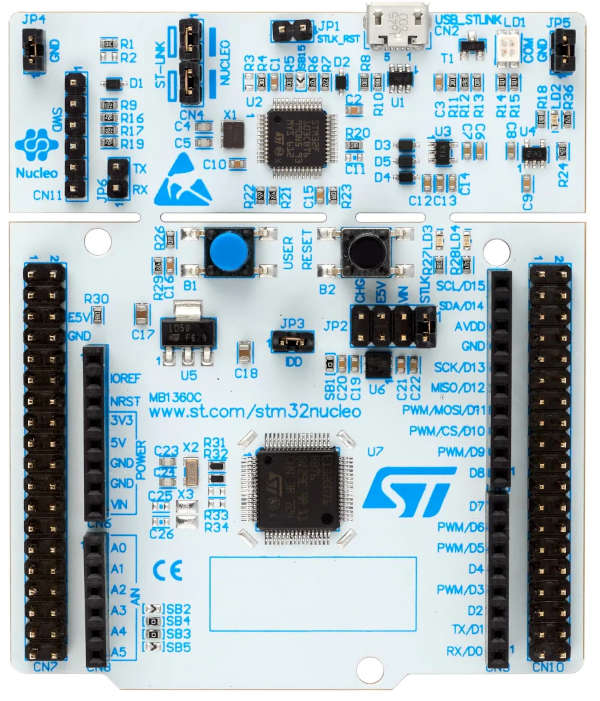ST Nucleo G070RB
Overview
The Nucleo G070RB board features an ARM Cortex-M0+ based STM32G070RB MCU with a wide range of connectivity support and configurations. Here are some highlights of the Nucleo G070RB board:
STM32 microcontroller in QFP64 package
Two types of extension resources:
Arduino Uno V3 connectivity
ST morpho extension pin headers for full access to all STM32 I/Os
On-board ST-LINK/V2-1 debugger/programmer with SWD connector
Flexible board power supply:
USB VBUS or external source(3.3V, 5V, 7 - 12V)
Power management access point
Three LEDs: USB communication (LD1), user LED (LD4), power LED (LD3)
Two push-buttons: USER and RESET

More information about the board can be found at the Nucleo G070RB website [1].
Hardware
Nucleo G070RB provides the following hardware components:
STM32 microcontroller in LQFP64 package
Two types of extension resources:
Arduino* Uno V3 connectivity
ST morpho extension pin headers for full access to all STM32 I/Os
ARM* mbed*
On-board ST-LINK/V2-1 debugger/programmer with SWD connector:
Selection-mode switch to use the kit as a standalone ST-LINK/V2-1
Flexible board power supply:
USB VBUS or external source (3.3V, 5V, 7 - 12V)
Power management access point
Three LEDs:
USB communication (LD1), user LED (LD4), power LED (LD3)
Two push-buttons: USER and RESET
USB re-enumeration capability. Three different interfaces supported on USB:
Virtual COM port
Mass storage
Debug port
Support of wide choice of Integrated Development Environments (IDEs) including:
IAR
ARM Keil
GCC-based IDEs
More information about STM32G070RB can be found here:
Supported Features
The Zephyr nucleo_g070rb board configuration supports the following hardware features:
Interface |
Controller |
Driver/Component |
|---|---|---|
MPU |
on-chip |
arm memory protection unit |
NVIC |
on-chip |
nested vector interrupt controller |
UART |
on-chip |
serial port-polling; serial port-interrupt |
PINMUX |
on-chip |
pinmux |
GPIO |
on-chip |
gpio |
I2C |
on-chip |
i2c |
SPI |
on-chip |
spi |
CLOCK |
on-chip |
reset and clock control |
FLASH |
on-chip |
flash memory |
COUNTER |
on-chip |
rtc |
WATCHDOG |
on-chip |
independent watchdog |
PWM |
on-chip |
pwm |
ADC |
on-chip |
adc |
die-temp |
on-chip |
die temperature sensor |
Other hardware features are not yet supported in this Zephyr port.
The default configuration can be found in the defconfig file: boards/st/nucleo_g070rb/nucleo_g070rb_defconfig
Connections and IOs
Each of the GPIO pins can be configured by software as output (push-pull or open-drain), as input (with or without pull-up or pull-down), or as peripheral alternate function. Most of the GPIO pins are shared with digital or analog alternate functions. All GPIOs are high current capable except for analog inputs.
Default Zephyr Peripheral Mapping:
UART_1 TX/RX : PC4/PC5
UART_2 TX/RX : PA2/PA3 (ST-Link Virtual Port Com)
I2C1 SCL/SDA : PB8/PB9 (Arduino I2C)
I2C2 SCL/SDA : PA11/PA12
SPI1 NSS/SCK/MISO/MOSI : PB0/PA5/PA6/PA7 (Arduino SPI)
SPI2 NSS/SCK/MISO/MOSI : PB12/PB13/PB14/PB15
USER_PB : PC13
LD4 : PA5
PWM : PA6
ADC1 IN0 : PA0
ADC1 IN1 : PA1
DAC1_OUT1 : PA4
For more details please refer to STM32 Nucleo-64 board User Manual [2].
Programming and Debugging
Nucleo G070RB board includes an ST-LINK/V2-1 embedded debug tool interface.
Applications for the nucleo_g070rb board configuration can be built and
flashed in the usual way (see Building an Application and
Run an Application for more details).
Flashing
The board is configured to be flashed using west STM32CubeProgrammer [4] runner, so its installation is required.
Alternatively, OpenOCD, JLink, or pyOCD can also be used to flash the board using
the --runner (or -r) option:
$ west flash --runner openocd
$ west flash --runner jlink
$ west flash --runner pyocd
Flashing an application to Nucleo G070RB
Here is an example for the Blinky application.
# From the root of the zephyr repository
west build -b nucleo_g070rb samples/basic/blinky
west flash
You will see the LED blinking every second.
Debugging
You can debug an application in the usual way. Here is an example for the Hello World application.
# From the root of the zephyr repository
west build -b nucleo_g070rb samples/hello_world
west debug
